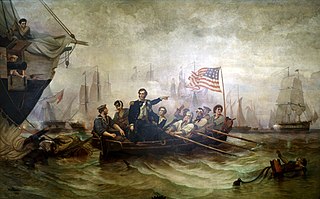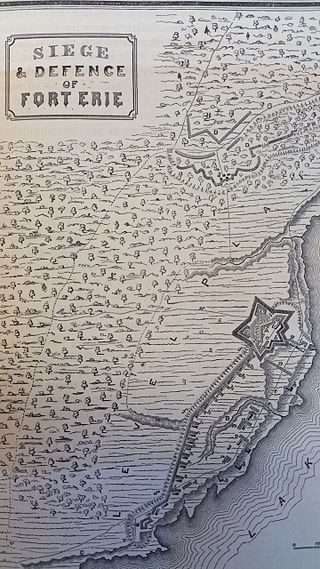
The Battle of the Thames, also known as the Battle of Moraviantown, was an American victory in the War of 1812 against Tecumseh's Confederacy and their British allies. It took place on October 5, 1813, in Upper Canada, near Chatham. The British lost control of Southwestern Ontario as a result of the battle; Tecumseh was killed, and his confederacy largely fell apart.

The Battle of Lake Erie, also known as the Battle of Put-in-Bay, was fought on 10 September 1813, on Lake Erie off the shore of Ohio during the War of 1812. Nine vessels of the United States Navy defeated and captured six vessels of the British Royal Navy. This ensured American control of the lake for the rest of the war, which in turn allowed the Americans to recover Detroit and win the Battle of the Thames to break the Indian confederation of Tecumseh. It was one of the largest naval battles of the War of 1812.

The Battle of Lundy's Lane, also known as the Battle of Niagara, was a battle fought on 25 July 1814, during the War of 1812, between an invading American army and a British and Canadian army near present-day Niagara Falls, Ontario. It was one of the bloodiest battles of the war, and one of the deadliest battles fought in Canada, with approximately 1,720 casualties including 258 killed.

Old Fort Erie, also known as Fort Erie, or the Fort Erie National Historic Site of Canada, was the first British fort to be constructed as part of a network developed after the Seven Years' War was concluded by the Treaty of Paris (1763), at which time France ceded its territories east of the Mississippi River to Great Britain. The installation is located on the southern edge of what is now the Town of Fort Erie, Ontario, directly across the Niagara River from Buffalo, New York, United States.

Peter Buell Porter was an American lawyer, soldier and politician who served as United States Secretary of War from 1828 to 1829.

The Battle of Chippawa, also known as the Battle of Chippewa, was a victory for the United States Army in the War of 1812, during its invasion on July 5, 1814, of the British Empire's colony of Upper Canada along the Niagara River. This battle and the subsequent Battle of Lundy's Lane demonstrated that trained American troops could hold their own against British regulars. The battlefield is preserved as a National Historic Site of Canada.

The Second Battle of Sacket's Harbor, or simply the Battle of Sacket's Harbor, took place on 29 May 1813, during the War of 1812. A British force was transported across Lake Ontario and attempted to capture the town, which was the principal dockyard and base for the American naval squadron on the lake. Twelve warships were built here. The British were repulsed by American regulars, militia, marines and sailors.


The siege of Fort Erie, also known as the Battle of Erie, from 4 August to 21 September 1814, was one of the last engagements of the War of 1812, between British and American forces. It took place during the Niagara campaign, and the Americans successfully defended Fort Erie against a British army. During the siege, the British suffered high casualties in a failed storming attempt; they also suffered casualties from sickness and exposure in their rough encampments. Unaware that the British were about to abandon the siege, the American garrison launched a sortie to destroy the British siege batteries, during which both sides again suffered high losses.
USS Caledonia was a brig, formerly HMS Caledonia, that the United States Navy captured during the War of 1812 and took into American service. The brig played an important role with the American squadron on Lake Erie, and was sold at the end of the war.

The Capture of Fort Niagara took place late in 1813, during the War of 1812 between the United Kingdom and the United States. The American garrison was taken by surprise, and the fort was captured in a night assault by a select force of British regular infantry.
USS Somers was a schooner, formerly Catherine, purchased by the United States Navy in 1812. She was purchased for $5,500 from Jacob Townsend, a pioneer and one of the first settlers of Lewiston, New York and purveyor of goods on the Great Lakes. She fought in the War of 1812 under the command of Commodore Oliver Hazard Perry on Lake Erie and Lake Huron, and took part in the capture of the British Squadron on 10 September 1813. She was captured by the British in 1814, and taken into service as HMS Huron.
The series of Engagements on Lake Huron left the British in control of the lake and their Native American allies in control of the Old Northwest for the latter stages of the War of 1812.
The 41st (Welch) Regiment of Foot was an infantry regiment of the British Army, raised in 1719. Under the Childers Reforms it amalgamated with the 69th Regiment of Foot to form the Welch Regiment in 1881.
HMS Lord Melville was a brig of the Royal Navy launched at Kingston, Ontario, on 20 July 1813. Initially designed as a schooner, she was altered to 14-gun brig in 1813. She served on Lake Ontario during the War of 1812, and was renamed HMS Star on 22 January 1814. By 1815, she was unfit for anything but transport duties. She was sold in 1837.

The Battle of Buffalo took place during the War of 1812 on December 30, 1813, in the State of New York, near the Niagara River. The British forces drove off the American defenders and destroyed many buildings and ships. The operation was retaliation for American troops burning the Canadian village of Newark.
The Battle of Conjocta Creek was an attempt by British forces under the command of Lieutenant Colonel John Tucker to raid the American supply depots at the towns of Black Rock and Buffalo. The Raid was ordered by British Lieutenant General Gordon Drummond in hopes of causing an early American surrender at Fort Erie. On the morning of August 3, 1814, Tucker and his men met a small force of American riflemen under the command of Major Lodwick Morgan. After fighting for about an hour, Tucker and his men were defeated, and withdrew across the Niagara river to Canada. The battle played a major role in the Siege of Fort Erie's failure, due to the supply post at Black Rock being able to continue supplying the American force defending Fort Erie. This resulted in the British eventually withdrawing from their siege positions around the fort to Chippawa on September 21, 1814.
Prince Regent was a schooner constructed for Upper Canada's Provincial Marine for use on Lake Ontario. Built just before the beginning of the War of 1812, the vessel took part in the attack on Sackett's Harbor, New York. With the arrival of the Royal Navy in the Great Lakes under the command of Commodore James Lucas Yeo in 1813, the vessel was renamed HMS Lord Beresford or General Beresford, or Beresford. The British detachment on the lake engaged the American naval squadron and attacked American positions in the Niagara region, while supporting British armies.












